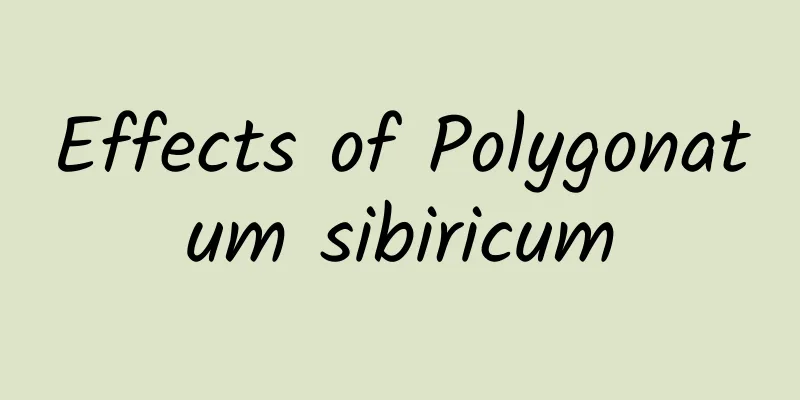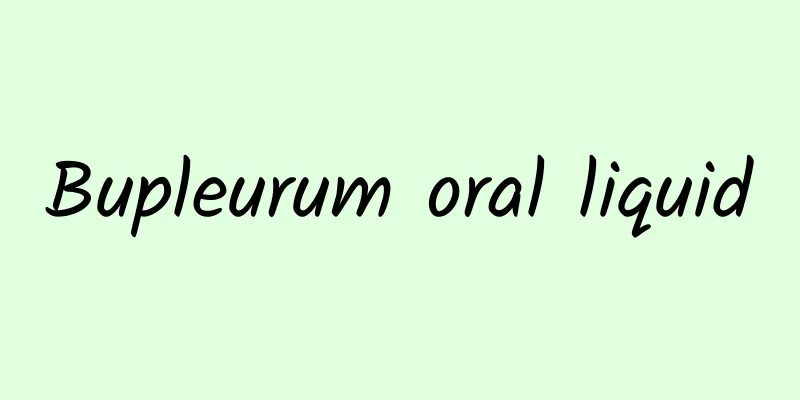Effects of Polygonatum sibiricum

|
Polygonatum sibiricum is a commonly used Chinese herbal medicine. This plant is widely distributed, so it is very helpful in treating diseases. In daily life, people may not call Polygonatum sibiricum "Polygonatum sibiricum". They may call it "yellow chicken vegetable" or "tiger ginger". This type of plant prefers to grow in damp and shady places. It is mostly found in the south of my country and has been used in traditional Chinese medicine since ancient times. When used in traditional Chinese medicine, the main effects of Polygonatum sibiricum are lowering blood lipids, lowering blood sugar and other cardiovascular diseases, so it will be of great benefit to some elderly people. However, it should be taken under the guidance of a doctor and should not be decocted and taken by yourself. "Compendium of Materia Medica" records that Polygonatum sibiricum enters the spleen, lung, and kidney meridians, replenishes essence, replenishes blood, replenishes various deficiencies, stops cold and heat, replenishes the middle and benefits qi, nourishes yin, calms the five internal organs, eliminates rheumatism, replenishes the five labors and seven injuries, replenishes the kidneys, helps the tendons and bones, benefits the spleen and stomach, moisturizes the heart and lungs, produces body fluids to resist cold and heat, and replenishes muscles to eliminate the three corpse worms. It is used for symptoms such as weak spleen and stomach, fatigue, soreness of waist and knees, kidney deficiency and essence deficiency, dry mouth and poor appetite, lung deficiency and dry cough, insufficient essence and blood, internal heat, thirst and hypertension. It is very effective for diabetes. Pharmacological effects of Polygonatum sibiricum: 1. Effect on blood sugar: When rabbits were gavaged with Polygonatum sibiricum extract, their blood sugar levels gradually increased and then decreased. Polygonatum sibiricum extract has a significant inhibitory effect on hyperglycemia caused by adrenaline. 2. Anti-fatigue effect: Intraperitoneal injection of 0.3 ml/mouse of 17.67% Polygonatum sibiricum decoction can prolong the swimming time of mice. 3. Antioxidant effect: 20% concentration of Polygonatum sibiricum decoction, 13 ml/mouse per day, for 27 consecutive days increased the activity of superoxide dismutase (SOD) in the mouse liver and reduced the content of myocardial lipofuscin. 4. Anti-aging effect: 20% concentration of Polygonatum sibiricum decoction is used to soak mulberry leaves and feed silkworms, which has the effect of prolonging the larval stage of silkworms. 5. Hemostatic effect: 40 mg/mouse of methanol extract of Polygonatum sibiricum, 20 mg/mouse of n-butanol fraction and 20 mg/mouse of aqueous fraction were injected intraperitoneally. The tail of mice was frozen with dry ice-methanol for 1 minute. The tail cutting experiment showed that it had a hemostatic effect and reduced the amount of bleeding in mice. 6. Cardiovascular effects: Intravenous injection of 0.16-0.26g/kg of Polygonatum sibiricum water extract significantly increased the coronary flow of anesthetized dogs; intravenous injection of 1.5g/kg had an antagonistic effect on myocardial ischemia in rabbits caused by vasopressin, antagonized the increase in T waves caused by vasopressin, and promoted the early recovery of T wave abnormalities; intraperitoneal injection of 12g/kg can enhance the tolerance of mice to hypoxia. 7. Antiviral effect: Polygonatum sibiricum polysaccharide 0.2% eye drops, 6 times/day, or taking Polygonatum sibiricum polysaccharide 10 mg/kg, 2 times/day, has a therapeutic effect on experimental herpes simplex virus keratitis in rabbits. The above is an introduction to the effects of Polygonatum sibiricum. I believe that after reading it, your impression of Polygonatum sibiricum will be deepened. There are many functions of Polygonatum sibiricum, all of which are health-preserving methods that are relevant to life. However, it should be noted that if you are weak or have a cough accompanied by phlegm, you should not take this type of Chinese medicine. |
<<: How long should Liuwei Dihuang Pills be taken?
>>: The difference between Korean ginseng and red ginseng
Recommend
The efficacy and function of red mushroom
The world is full of wonders, and Chinese medicin...
What are the medicinal values of King Kong Teng?
Many people don’t know what Vajra vine is. In fac...
Today, we pay tribute to these bright stars.
Their sincere devotion to the motherland, their i...
Seriously, it’s better to throw your underwear and socks into the washing machine than to wash them by hand!
When you are busy at work, you will inevitably wa...
The coldest winter is coming? Are you freezing cold? Is La Nina to blame?
This article was first published by Hunzhi (WeCha...
Ear piercing causes intracranial infection. Can a small ear piercing cause such a big harm?
Ear piercing has been a common thing since ancien...
Do you know the effects and functions of red and white peony root?
Although peony is a kind of flower, it is also a ...
How to welcome the New Year safely? Please take these health tips
New Year's Day is coming, how do you plan to ...
The efficacy and effects of horse meat
Horse meat is a very common type of traditional C...
Middle-aged people die of melanoma. The "effect" of ultraviolet rays is beyond your imagination.
The benefits of ultraviolet light to people go fa...
Are the Beijing Winter Olympics commemorative banknotes made of plastic? In fact, the banknotes of these countries are not "paper" either
The ice sports commemorative banknote issued by t...
Infrastructure maniac, he has his own tricks for sand control!
In recent years, going to the desert for fun has ...
Saudi Arabia's e-commerce market reached $2.7 billion in 2015
According to Zamar, chairman of the Wheat Process...
Today’s little-known fact: Japanese tofu is even worse than eggs!!!
The 5th issue of Eight Little-Known Facts is now ...









